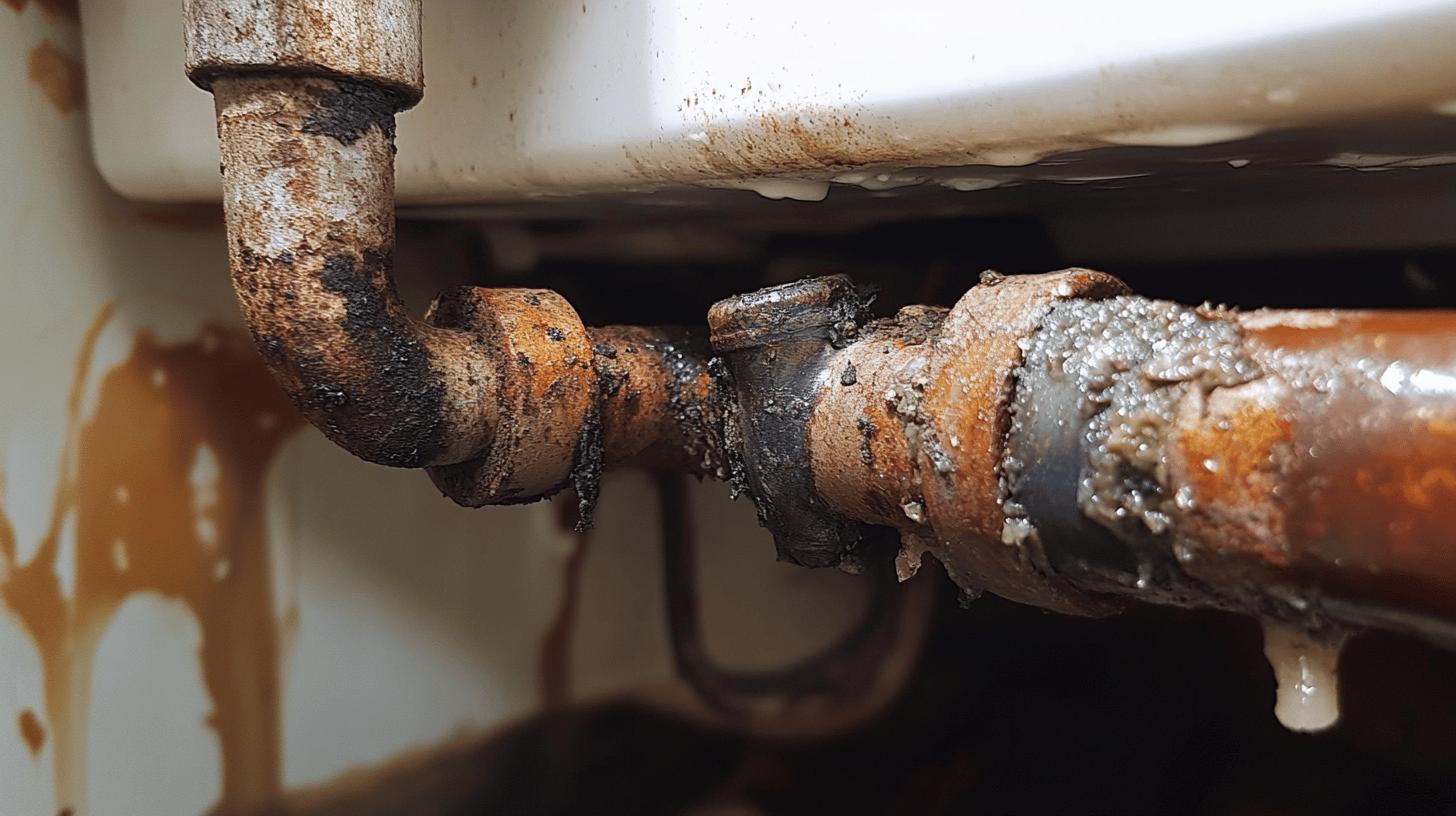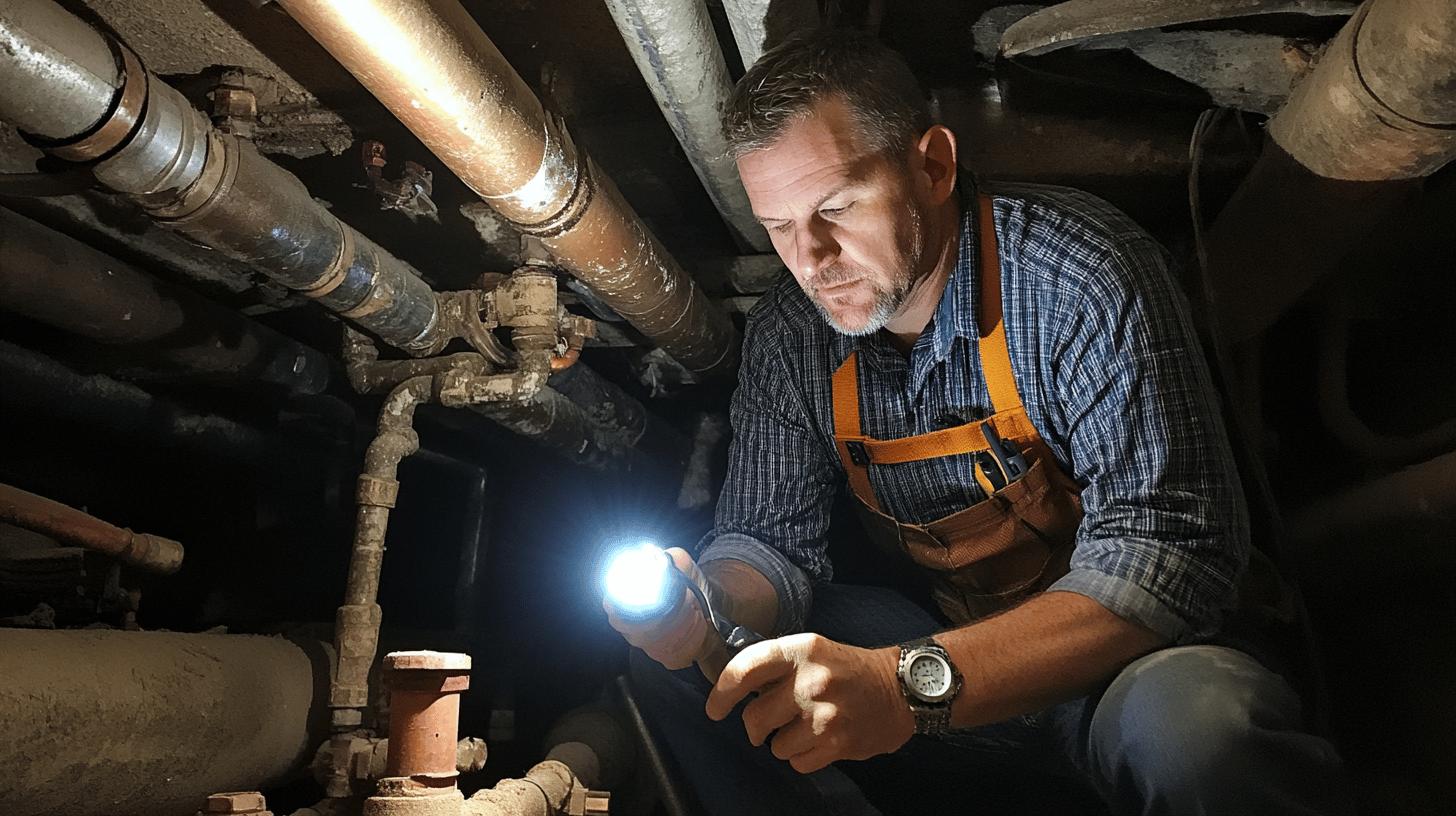TL;DR:
- Galvanized pipes, coated in zinc, prevent rust but may corrode after 40-100 years.
- Identify by appearance, scratch test, magnet test, and water quality.
- Signs for replacement: low water pressure, visible rust, leaks, unequal pressure.
- Health risks include lead poisoning from corroded pipes.
- Replacement options: Copper (durable, costly), PEX (flexible, cost-effective), PVC (lightweight, affordable).
- Replacement costs range from $2,000 to $15,000, influenced by property size and pipe type.
- Hire licensed professionals for quality installation and compliance with codes. Factors for hiring include licensing, experience, reputation, insurance, and cost estimates.
Are your galvanized pipes a ticking time bomb? These pipes were once the go-to choice for plumbing, but now they’re nearing the end of their lifespan in many American homes. With a typical lifespan of 40 to 100 years, many of these pipes are due for retirement. But how can you tell if it’s time for a replacement?
As you consider the risks and hidden costs of old plumbing, you’ll also discover modern alternatives that offer better efficiency and safety. Keep reading to learn how aging pipes might affect both your home and your wallet.
Understanding Galvanized Pipes and Their Lifespan
Galvanized pipes are steel pipes coated with zinc to prevent rust. They were widely used in homes before the 1960s for their durability. While the zinc layer initially acts as a shield against rust, it can wear away over time, exposing the steel underneath to moisture and corrosion.
To identify galvanized pipes in your home, look for these clues:
- Visual Inspection: Pipes may look like dull or darkened nickel.
- Scratch Test: Scratch the pipe’s surface. If you see silver-gray metal, it’s likely galvanized steel.
- Magnet Test: A magnet will stick to galvanized pipes due to their iron content.
- Pipe Fittings: Look for threaded fittings, as these are typical for galvanized pipes.
- Water Quality Check: Brownish water can indicate corrosion.
Galvanized pipes typically last between 40 to 100 years, depending on factors like the environment and water quality. If your home still has original galvanized plumbing, it may be approaching the end of its lifespan, which raises the chances of leaks or low water pressure. Regular inspections are essential to assess whether replacement is needed to prevent plumbing issues.
Risks and Signs Indicating Galvanized Pipe Replacement

Galvanized pipes can be harmful to both your plumbing and health. Over time, corrosion and mineral buildup can reduce water pressure and cause discoloration. As the zinc coating wears away, the exposed steel can rust and potentially release harmful materials into your water supply. Additionally, older systems may have used zinc coatings that contained lead, which poses serious risks, particularly for children.
Signs you might need to replace galvanized pipes include:
- Low Water Pressure: Reduced flow might mean buildups or corrosion.
- Rusty Pipes: Visible rust indicates deterioration and potential leaks.
- Persistent Leaks: Leaks around joints suggest failing pipes.
- Unequal Water Pressure: Inconsistent pressure can signal blockages.
Health Hazards of Corroded Pipes
Corroded pipes can significantly raise health risks, especially concerning lead poisoning. Lead is toxic and can lead to developmental and learning problems in children, as well as health issues in adults. Additionally, rust and contaminants can negatively impact the taste, odor, and safety of your water.
Ignoring problems with galvanized pipes can result in serious damage and health threats. Corrosion can lead to pipe failures and water damage, making it essential to replace old pipes promptly. By doing so, you can prevent extensive damage and ensure safe drinking water. Modern plumbing alternatives not only reduce these risks but also provide peace of mind regarding water quality and safety.
Benefits and Options for Replacing Galvanized Pipes
Is it time to replace your galvanized pipes? Absolutely! Replacing them can greatly improve your water quality and plumbing reliability. Galvanized pipes are known for corroding over time, which can lead to low water pressure and health risks like lead contamination. Upgrading your plumbing will enhance water pressure, reduce leaks, and eliminate the dangers posed by corroded pipes, ensuring a safer and more efficient plumbing system.
Modern alternatives to galvanized pipes offer distinct benefits:
- Copper Pipes: Known for durability and long service, they resist corrosion well. Though costly, they offer superior performance.
- PEX Pipes: Flexible and easy to install, PEX offers a cost-effective choice.
- PVC Pipes: Lightweight and corrosion-resistant, PVC is affordable and suitable for many applications.
Replacing galvanized pipes involves a few key steps. First, a professional plumber will evaluate your existing plumbing system and recommend the best materials for replacement. Next, they’ll remove the old pipes and install new ones, making sure everything meets local plumbing codes. Hiring professionals ensures a safe and efficient installation, giving you peace of mind about your plumbing.
| Material | Benefits | Installation Ease |
|———-|————————————-|——————-|
| Copper | Durable and long-lasting | Moderate |
| PEX | Flexible and cost-effective | Easy |
| PVC | Lightweight and corrosion-resistant | Easy |
Cost Considerations for Replacing Galvanized Pipes

What does pipe replacement cost? Replacing galvanized pipes typically ranges from $2,000 to $15,000. The final cost depends on the size of your property and the type of pipes you choose. Copper pipes are durable but more expensive due to the cost of the raw material. In contrast, PEX and PVC are more budget-friendly options, known for their flexibility and resistance to corrosion.
Factors influencing replacement cost:
- Property Size: Larger homes need more materials and labor.
- Pipe Type: Copper is costlier than PEX or PVC.
- Installation Complexity: Older or uniquely structured homes might be more challenging.
Why hire professional plumbers? They provide the expertise needed for a proper installation, ensuring everything is done right. Professionals also make sure your plumbing complies with local codes, reducing the risk of future problems. Investing in their services not only guarantees quality workmanship but also helps your plumbing system run efficiently for a longer time.
Professional Plumbing Advice for Galvanized Pipe Replacement
Wondering if you should replace your galvanized pipes? Absolutely! Experts recommend doing it to avoid issues down the line. Skilled plumbers can evaluate the condition of your pipes, suggest the best replacement options, and ensure everything is installed according to local codes. By hiring licensed professionals, you can trust the quality of the work and reduce the risks of leaks or water contamination.
When selecting a plumbing contractor, consider these points:
- Licensing and Certification: Confirm their credentials.
- Experience: Seek seasoned professionals for pipe replacements.
- Reputation: Read reviews and check references for reliability.
- Insurance: Ensure they have liability coverage for potential damages.
- Estimates: Get clear cost and timeline estimates.
Hiring professional plumbers is essential for safely replacing your pipes. They know local codes and make sure installations meet the required standards, keeping your home safe from issues like faulty connections. When you choose professionals, you can trust that the removal and installation will be done right, protecting your investment in the long run.
Final Words
Deciding whether to replace your galvanized pipes is an important part of home maintenance. By learning about the materials and lifespans of these older pipes, you can spot potential risks and signs of failure that might affect your health and safety.
Modern alternatives provide major advantages, not just in performance but also in lowering long-term costs. Weighing the financial factors and the importance of professional help will help you make a smart choice.
When you’re wondering, “Should I replace my galvanized pipes?” remember that prioritizing safety and reliability brings peace of mind and a healthier home.
FAQ
Should I replace galvanized pipes in my house?
Replacing galvanized pipes in your house is recommended due to risks of corrosion, potential lead contamination, and reduced water pressure. Modern alternatives offer improved safety and efficiency.
Is it worth replacing galvanized pipes?
The benefits of replacing galvanized pipes include better water pressure, reduced leaks, and improved safety. These upgrades can enhance your home’s value and avoid costly repairs linked to old plumbing.
What is the cost of replacing galvanized pipes with PEX or PVC?
Replacing galvanized pipes with PEX or PVC can range from $2,000 to $15,000. Costs depend on factors like pipe material, property size, and labor. PEX and PVC are cost-effective compared to copper.
Does replacing galvanized pipes increase home value?
Replacing galvanized pipes can increase home value by eliminating health risks and improving water flow. This upgrade attracts buyers aware of plumbing issues related to older systems.
How many years do galvanized pipes last?
Galvanized pipes usually last 40 to 100 years. Lifespan depends on water quality and environmental conditions. Regular inspection is advised to detect signs of wear or failure early.
What are the dangers of galvanized water pipes?
Galvanized water pipes carry dangers like lead contamination, corrosion, and mineral accumulation. These can lead to discolored water, health risks, and lowered water pressure in homes.
When was galvanized plumbing discontinued?
Galvanized plumbing was widely discontinued in the 1960s. Newer materials, such as copper and plastic pipes, offered better durability and safety, leading to a transition in residential plumbing preferences.
Should I replace galvanized plumbing with PEX?
PEX is a popular choice for replacing galvanized plumbing due to its flexibility, ease of installation, and resistance to corrosion. Consider consulting a professional to ensure it meets your needs and locale’s codes.
Is professional plumbing advice essential for galvanized pipe replacement?
Professional plumbing advice is vital when replacing galvanized pipes, ensuring proper assessment, material selection, and code compliance. Hiring a licensed contractor guarantees quality work and minimizes future risks.

